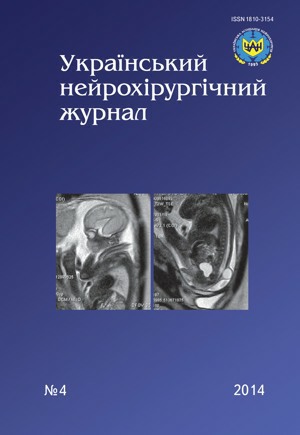New approaches to verapamil and ketamine use in brain gliomas treatment
DOI:
https://doi.org/10.25305/unj.46597Keywords:
verapamil, ketamin, brain glioma, NMDA-receptors, surface plasmon resonance, tumor-associated inflammation, blood cells aggregation, glioma 101.8Abstract
Introduction. A new experimental approach to channel blockers verapamil and ketamine use in treatment of malignant brain gliomas was elaborated on highly invasive and malignant rat glioma strain 101.8 taking into consideration influence of pathogenic mechanism on ionotropic NMDA-receptors mediated through blood cells aggregation.
Materials and methods. Effects of verapamil and ketamine in different dilutions (10-1-10-6) on blood cells aggregation were studied in 312 patients with neurosurgical diseases and 15 Wistar rats. Experimental testing of the method was performed in 70 rats, which received drugs in concentrations that maximally reduced blood cells aggregation as in patients with glioblastoma and rats with glioma 101.8, in order to inhibit it’s growth.
Results. Channel blockers administration in concentrations that optimally decreased blood cells aggregation in patients with glioblastoma and experimental animals, most effectively inhibited glioma’s 101.8 growth in rats.
Conclusions. It has been experimentally proved that use of verapamil and ketamine in low concentrations effectively decreased blood cells aggregation in patients with neurosurgical diseases through inhibition of activity of ionotropic NMDA-receptors. New approaches of verapamil and ketamine use for antitumor effect at brain glioma through NMDA-receptors channel blocking were elaborated.
References
Fidler IJ. The organ microenvironment and cancer metastasis. Differentiation. 2002;70(9-10):498-505. PubMed
Luchnik A. Obshcheye zveno v mekhanizme samopodderzhaniya zlokachestvennogo rosta: sindrom nezazhivayushchey rany. Ontogenez. 2000; 31(3):227–231. Russian.
Schwartsburd PM. Chronic inflammation as inductor of pro-cancer microenvironment: pathogenesis of dysregulated feedback control. Cancer Metastasis Rev. 2003;22(1):95-102. PubMed
Bardia A, Ebbert J, Vierkant R et al. Association of Aspirin and Nonaspirin Nonsteroidal Anti-inflammatory Drugs With Cancer Incidence and Mortality. JNCI Journal of the National Cancer Institute. 2007;99(11):881-889. CrossRef
Savaskan N, Seufert S, Hauke J, Tränkle C, Eyüpoglu I, Hahnen E. Dissection of mitogenic and neurodegenerative actions of cystine and glutamate in malignant gliomas. Oncogene. 2010;30(1):43-53. CrossRef
Fu Y, Lin Y, Chou S et al. Tetramethylpyrazine inhibits activities of glioma cells and glutamate neuro-excitotoxicity: Potential therapeutic application for treatment of gliomas. Neuro-Oncology. 2008;10(2):139-152. CrossRef
Sakai T, Ichiyama T, Whitten C, Giesecke A, Lipton J. Ketamine suppresses endotoxin-induced NF-κB expression. J Can Anesth. 2000;47(10):1019-1024. CrossRef
Vereshchagin Ye. Sovremennyye vozmozhnosti neyroprotektsii pri ostrykh narusheniyakh mozgovogo krovoobrashcheniya i cherepno-mozgovoy travme (obzor literatury). Zhurn Intensiv Terapii. 2006;(3):4-28.
Bespalov A, Zvartau E. Neyrofarmakologiya antagonistov NMDA-retseptorov. [Neuropharmacology NMDA-receptor antagonists] St. Petersburg: Nevsky Dialect; 2000.
Clements J, Lester R, Tong G, Jahr C, Westbrook G. The time course of glutamate in the synaptic cleft. Science. 1992;258(5087):1498-1501. CrossRef
Parsons C, Danysz W, Bartmann A et al. Amino-alkyl-cyclohexanes are novel uncompetitive NMDA receptor antagonists with strong voltage-dependency and fast blocking kinetics: in vitro and in vivo characterization. Neuropharmacology. 1999;38(1):85-108. CrossRef
Rogawski M. Therapeutic potential of excitatory amino acid antagonists: channel blockers and 2,3-benzodiazepines. Trends in Pharmacological Sciences. 1993;14(9):325-331. CrossRef
Schmidt WF, Huber KR, Ettinger RS, Neuberg RW. Antiproliferative effect of verapamil alone on brain tumor cells in vitro. Cancer Res. 1988;48(13):3617-3621. PubMed
Bondeson K, Frostellkarlsson A, Fagerstam L, Magnusson G. Lactose Repressor-Operator DNA Interactions: Kinetic Analysis by a Surface Plasmon Resonance Biosensor. Analytical Biochemistry. 1993;214(1):245-251. CrossRef
Gridina N, Dorozinsky G, Khristosenko R, Maslov V, Samoylov A, Ushenin Yu, Shirshov Yu. Surface plasmon resonance biosensor. Sensors & Transducers. 2013;149(2):60–68
Downloads
Published
How to Cite
Issue
Section
License
Copyright (c) 2014 Nina Gridina, Vadym Biloshytsky, Anatoliy Morozov, Volodymyr Rozumenko, Nataliya Draguntsova, Olga Velichko, Olga Veselova, Volodymyr Maslov, Yury Ushenin

This work is licensed under a Creative Commons Attribution 4.0 International License.
Ukrainian Neurosurgical Journal abides by the CREATIVE COMMONS copyright rights and permissions for open access journals.
Authors, who are published in this Journal, agree to the following conditions:
1. The authors reserve the right to authorship of the work and pass the first publication right of this work to the Journal under the terms of Creative Commons Attribution License, which allows others to freely distribute the published research with the obligatory reference to the authors of the original work and the first publication of the work in this Journal.
2. The authors have the right to conclude separate supplement agreements that relate to non-exclusive work distribution in the form of which it has been published by the Journal (for example, to upload the work to the online storage of the Journal or publish it as part of a monograph), provided that the reference to the first publication of the work in this Journal is included.









